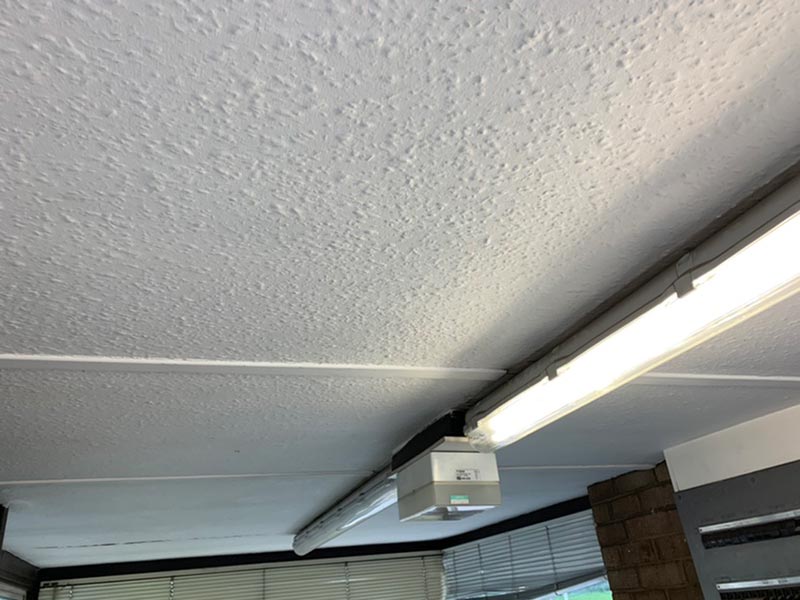Can I safely remove Artex and is it dangerous?
Artex is an interior decorating coating typically found on ceilings and walls that adds texture to the surface.
While the word “Artex” is a trademark of the Artex Ltd. company, it’s also used to refer to textured decorative coatings not made by the Artex brand. Other times, the term “textured coatings” is used to refer to Artex and Artex-like materials.
You may have also heard the term “popcorn ceiling,” which refers to a textured coating that’s sprayed or painted onto the ceiling and has a bumpy surface.
These types of coatings were once popular because they could help with acoustics by deafening sound. Plus, the textured appearance was ideal for hiding imperfections on the ceiling or walls.

Does my property contain Artex?
Artex was especially popular to use in UK homes built or renovated in the 1970s. A telltale sign that a home has Artex is a stippled or swirled pattern on the ceiling or walls.
Prior to the asbestos ban in 1999, most textured coatings, including Artex, contained asbestos. Adding asbestos to surface coatings provided strength and fire resistance.
Today, textured coatings are still sold. However, they no longer contain asbestos, and they’re also not as popular as they once were.
Can Artex lead to asbestos exposure?
Artex is only harmful if it’s been disturbed or damaged and it’s turned into powder, which releases asbestos fibres into the air. This can happen if it’s sanded or if holes are drilled into it.
Otherwise, Artex doesn’t pose a risk in its undisturbed state. It’s also safe to cover Artex with emulsion paint.
Why is Artex removal a high-risk activity?
Removing Artex and other types of textured coatings can be difficult. Even non-asbestos coatings can pose a health risk due to the release of dust particles, which carry their own hazards.
Asbestos coatings are particularly dangerous when fibres go airborne. Ingesting or inhaling asbestos fibres can cause asbestosis, mesothelioma and other life-threatening diseases.
Can I remove Artex myself?
While you can technically remove Artex and other asbestos materials yourself, it’s not recommended. DIY asbestos removal has the potential to unknowingly cause an exposure event, which will put you, your loved ones and anyone in the vicinity in danger.
Additionally, if the asbestos removal job should be handled by a licensed contractor, you could face legal trouble for attempting the project without the proper licensing.
In general, removing damaged ACMs is extremely dangerous, and you should never do it on your own. Furthermore, working with asbestos materials that can easily be damaged and release asbestos dust, like Artex, is also unsafe.
Common mistakes homeowners make when attempting asbestos removal themselves
- Assuming there’s a safe amount of exposure. Any amount of asbestos exposure can be harmful.
- Neglecting to close off the work area. The only way to prevent the spread of asbestos fibres throughout the rest of the commercial building or residence is to adequately isolate the work area, which includes removing items from it before work begins.
- Wearing a simple face mask and regular clothes. Asbestos removal requires specific protective equipment, like a respirator and disposable clothing.
- Using power tools for asbestos removal. Anything abrasive, like a cutting disc or a sander, can damage Artex and release fibres.
- Disturbing the asbestos more during the project. For example, even sweeping or vacuuming up asbestos dust can spread fibres through the air and create more of an exposure event.
Should I hire an asbestos expert to remove Artex?
Only an asbestos professional should identify asbestos-containing materials (ACMs), including Artex, and remove the coating.
Experts know the safety precautions to take and have the necessary equipment for the job, including dust-proof clothing and respiratory equipment that will keep them safe from exposure.
Additionally, they’ll seal off the work area to limit the chance that asbestos fibres will spread throughout the rest of the building or home.
Following removal, the ACMs and debris must be disposed of correctly. Anything with asbestos is considered hazardous waste, and it needs to be bagged, labeled, transported and disposed of according to The Control of Asbestos Regulations 2012.
What is the safest way to remove Artex?
The first step to removing Artex is to test for asbestos in the textured coating. If the coating doesn’t contain asbestos, you may not have to hire an asbestos contractor. In this case, the steaming method is a good way to remove a non-asbestos textured coating.
Keep in mind that even taking a sample of the coating is enough disturbance to release asbestos dust, so it’s best to hire a professional asbestos sampler to handle this for you.
What is the wetting method?
An asbestos specialist will likely use the wetting method to remove Artex. Without a wet process, disturbing the Artex during removal could result in the release of asbestos fibres.
For the wetting system, a non-hazardous, non-toxic and non-flammable water-based product is used to dampen the coating. This turns the Artex into a gel-like material that can then be safely scraped off.
Even though the wetting product makes it safer to work with Artex, it’s still necessary to wear protective equipment, including respiratory equipment and disposal clothing like gloves and coveralls. Also, nobody else aside from the asbestos workers should be in the room while the removal project is taking place.
Is there an alternative to removing asbestos Artex?
Yes, if you don’t want to remove the Artex, you can opt to cover it using plasterboard.
This process involves layering plasterboard over the existing surface and securing it to the surface so it’s completely covered.
In addition to protecting the Artex from being disturbed, it’s a good way to create a new surface that’s more modern and looks better than the textured coating.
The key when using this method is to be careful if you need to do work on the ceiling or walls in the future. Working on the plasterboard could potentially damage the asbestos coating underneath, which you’ll want to either avoid or prepare for by hiring an asbestos expert.
What are the costs associated with removing Artex?
The cost of removing Artex will vary based on your specific situation. For example, the surface type that the Artex is applied to can affect the cost.
Also, there are additional costs that you may need to prepare for, such as relocating while the work is being done and restoration costs to fix damage that exists post-removal.
Artex removal costs by surface type
Artex on plasterboard is the easiest surface for a removal job. The plasterboard can be completely removed and disposed of instead of trying to remove the Artex from the plasterboard.
If Artex was applied to plaster finish, this is a more complex process. The plaster surface has to be returned to its original state, and then it may need to be replastered once the Artex is removed.
When it comes to Artex on concrete, the coating has to be removed without damaging the concrete. This is usually done with the wetting method.
Working with plasterboard is the most cost-effective type of Artex removal job. Working with a plaster or concrete finish are significantly more costly, with concrete Artex removal being the most expensive option.
For example, removal in a 50-square-metre work space costs £46 per square metre for a plasterboard finish, £56 per square metre for a plaster finish and £61 per square metre for a concrete finish.
Artex removal costs by total area
Removal project costs will also vary based on the size of the work area, though in this case, the larger the area, the lower the cost by square metre.
For example, a plasterboard removal job in a 20-square-metre home costs £50 per square metre. In a 200-square-metre home, the cost goes down to £40 per square metre.
While the overall cost will be higher because you have more space to cover, the per-square-metre cost goes down as the work area increases.
Final thoughts: Is it safe to remove Artex on your own?
Professional removal is the safest option when dealing with any ACMs, including Artex or another type of textured coating with asbestos. Always consult with a qualified contractor to ensure safe, legal asbestos removal before beginning the project.
If you’re not able to remove the Artex coating immediately, there are precautions you can take to stay safe in the meantime. First, avoid disturbing the ceiling or walls. Don’t drill into the wall, sand the ceiling, hammer a nail into the surface, or do anything that could damage the coating. Then, consider encapsulating the exposed area using an adhesive or paint that’s designed for that purpose.
While Artex removal may be costly, especially if you have a large area to cover, keeping yourself and your loved ones safe is more valuable. Additionally, responsible asbestos remediation can raise your long-term property value, which will be a big help when it’s time to sell.
To speak with an asbestos removal consultant, contact the team at Oracle Solutions today.

Written by Callum McDonald
Callum McDonald is an expert in asbestos quality management, ensuring rigorous adherence to regulations and high-quality standards in removal projects. His focus on enhancing quality and client satisfaction makes him a crucial asset in safety and compliance within the field. Callum's expertise in technical support and oversight of licensed works underscores his commitment to excellence in asbestos management, providing invaluable guidance to clients in this specialised area.
